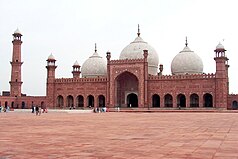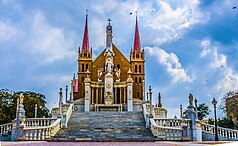| Part of a series on the |
| Culture of Pakistan |
|---|
 |
| Traditions |
| folklore |
| Sport |
The official religion of Pakistan is Islam, as enshrined by Article 2 of the Constitution, and is practised by an overwhelming majority of 96.35% of the country's population.[1][7] The remaining 3.65% practice Hinduism, Christianity, Ahmadiyya (considered a non-Muslim group as per Pakistani constitution[8]), Sikhism, Zoroastrianism and other religions.[9][10]
A few aspects of secularism have also been adopted by Pakistani constitution from British colonial concept.[9][11][12][13][14] However, religious minorities in Pakistan often face significant discrimination, subject to issues such as violence and the blasphemy laws.[15][16]
Muslims comprise a number of sects: the majority practice Sunni Islam (estimated at 90%), while a minority practice Shia Islam (estimated at 10%).[17][18][19] Most Pakistani Sunni Muslims belong to the Hanafi school of jurisprudence,[9] which is represented by the Barelvi and Deobandi traditions. However, the Hanbali school is also gaining popularity due to Ahl-i Hadith and Wahhabi influence from the Middle East.[20] The majority of Pakistani Shia Muslims belong to the Twelver Islamic law school, with significant minority groups who practice Ismailism, which is composed of Nizari (Aga Khanis), Mustaali, Dawoodi Bohra, Sulaymani, and others.
Before the arrival of Islam beginning in the 8th century, the region comprising Pakistan was home to a diverse plethora of faiths, including Hinduism, Buddhism, Jainism and Zoroastrianism.[21][22]
- ^ a b "Religious Demographics of Pakistan" (PDF).
- ^ "Religions in Pakistan | PEW-GRF". www.globalreligiousfutures.org.
- ^ Cite error: The named reference
refworld.orgwas invoked but never defined (see the help page). - ^ Haq, Riazul; Rana, Shahbaz (27 May 2018). "Headcount finalised sans third-party audit". Retrieved 23 January 2021.
- ^ "Population By Religion" (PDF). Pakistan Bureau of Statistics, Government of Pakistan: 1.
"Population Distribution by Religion, 1998 Census" (PDF). Pakistan Bureau of Statistics. Retrieved 12 July 2020. - ^ West, Barbara A. (19 May 2010). Encyclopedia of the Peoples of Asia and Oceania. Infobase Publishing. p. 357. ISBN 9781438119137.
- ^ "Part I: "Introductory"". www.pakistani.org.
- ^ "Surviving as an Ahmadi in Pakistan | Pulitzer Center".
- ^ a b c Esposito, John L., ed. (2003). "Pakistan, Islam in". The Oxford Dictionary of Islam. New York, New York: Oxford University Press. p. 242. ISBN 0-19-512558-4.
Approximately 97 percent of Pakistanis are Muslim. The majority are Sunnis following the Hanafi school of Islamic law. Between 10 and 15 percent are Shiis, mostly Twelvers.
- ^ "Religions: Muslim 97% (Sunni 75%, Shia 20%), other". Pakistan (includes Christian and Hindu) 4%. The World Factbook. CIA. 2010. Archived from the original on 17 June 2009. Retrieved 28 August 2010.
- ^ 2014 World Population Data Sheet (PDF). Population Reference Bureau (Report). August 2014. Archived from the original (PDF) on 18 February 2018. Retrieved 24 October 2014.
- ^ Information on other countries: http://hdr.undp.org/en/media/HDR_20072008_EN_Complete.pdf [page needed]
- ^ "Country Profile: Pakistan" (PDF). Library of Congress Country Studies on Pakistan. Library of Congress. February 2005. Retrieved 1 September 2010.
Religion: About 97% of Pakistanis are Muslim, 64% of whom are Sunni and 33% Shia; the remaining 3% of population divided equally among Christian, Hindu, and other religions
- ^ "Population: 174,578,558 (July 2010 est.)". Central Intelligence Agency. The World Factbook on Pakistan. Archived from the original on 17 June 2009. Retrieved 28 August 2010.
- ^ GHRD Human Rights Report 2019 (PDF) (Report). Global Human Rights Defence. 7 March 2019. Archived from the original on 19 September 2019. Retrieved 13 September 2022.
{{cite report}}: CS1 maint: unfit URL (link) - ^ Cite error: The named reference
:3was invoked but never defined (see the help page). - ^ Cite error: The named reference
LoC_Pakwas invoked but never defined (see the help page). - ^ Cite error: The named reference
CIAwas invoked but never defined (see the help page). - ^ "The World's Muslims: Unity and Diversity". Pew Research Center. 9 August 2012. Retrieved 26 December 2016.
On the other hand, in Pakistan, where 6% of the survey respondents identify as Shia, Sunni attitudes are more mixed: 50% say Shias are Muslims, while 41% say they are not.
- ^ "Pakistan must confront Wahhabism | Adrian Pabst". TheGuardian.com. 20 August 2009.
- ^ Stubbs, John H.; Thomson, Robert G. (10 November 2016). Architectural Conservation in Asia: National Experiences and Practice. Taylor & Francis. p. 427. ISBN 978-1-317-40619-8.
Perhaps best known as home to Asia's earliest cities, the Harappan sites of Mohenjo-Daro and Harappa, Pakistan's rich history includes contributions from prominent Buddhist, Hindu, Hellenistic, Jain and Zoroastrian civilizations, as well as those connected to its Islamic heritage.
- ^ Malik, Iftikhar Haider (2006). Culture and Customs of Pakistan. Greenwood Publishing Group. p. 47. ISBN 978-0-313-33126-8.



